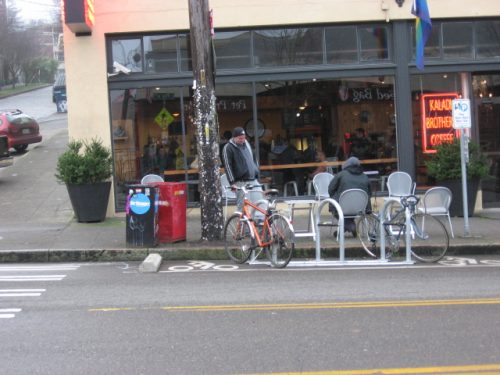Implementation and Operation
Partnerships
SDOT reserves the sole responsibility of designing and implementing adaptive design treatments. However, residents, community groups, and businesses are encouraged to suggest locations for these treatments. For locations where adaptive design treatments are accepted, the champion is encouraged, but not required, to work with SDOT planning and design staff to build support for the measure in their community, to provide input on design options, and to assist in evaluation.
Community partnerships offer the opportunity to utilize the public right-of-way for an adaptive treatment on an annually permitted basis, but also require significant resources and responsibility. Community partners are responsible for all design, permitting, and construction costs of their projects. As part of introducing a new use into the right-of-way, Community partners are also responsible for on-going maintenance and ensuring that the space is continuously programmed and open to public. Programming the space provides partners with the opportunity to tailor it to their own vision – whether as an extension of café space in a streatery or as a location for markets, festivals, or recreation on a plaza.
Design and Review
Community partners work with SDOT staff to determine the exact location, design, materials, and parties responsible for each element of the adaptive design treatment. Partners provide a site plan and concept for their treatment to be reviewed by SDOT. Following approval by SDOT and the public, the Partner is awarded a permit to be renewed on an annual basis.
Funding
Adaptive strategies can be implemented through a variety of funding strategies. Community Partners are responsible for funding all aspects of projects from concept to construction through maintenance and daily use. Eligible partners are encouraged to apply for Neighborhood Matching Fund grants through the Department of Neighborhoods in order to fund all or some of their project costs. Design assistance may be available through non-profit community design centers or pro bono design services for partners with limited resources.
SDOT has funding to design and deliver approximately four pavement to parks projects per year. SDOT identifies projects based on the project selection criteria below:
- Project funding: does the project use low cost, temporary materials? Is there a funding partner available?
- Community involvement and outreach: has this project been identified by the community? is the program well-supported by the surrounding community?
- Open space: is the project located in an area deficient of public open space?
- Race and social justice: is the project in a traditionally underserved neighborhood? Would the project increase the geographic diversity of the program?
Funding does not typically cover long-term costs including maintenance or annual permitting costs.
Maintenance
Adaptive design treatments should have a positive impact on their immediate vicinity – from the aesthetic benefits of context-sensitive design and high-quality materials to enlivening spaces that were formerly inactive – they should enhance and strengthen their neighborhoods by displaying renewed care for their space. This includes ensuring that the space is always usable for people of all ages and abilities, maintaining site furniture, fixtures and vegetation, and disposing of rubbish accumulated through use.
Evaluation
Since adaptive design strategies are temporary by nature, they provide a unique opportunity for SDOT and its community partners to monitor their use and effectiveness before deciding whether to invest in a permanent solution. The goals of evaluation are to provide measurements of public use, diversity of users, public perception, local economic impacts, and effects on parking supply and traffic. The evaluation process is managed by SDOT staff in collaboration with Partners who may conduct surveys and observations.
Evaluation should provide objective, measurable data, utilizing a standardized set of criteria and tools for each design treatment both before and after installation. Evaluation of each individual treatment should result in a standardized dataset, in order to allow a broader analysis of the adaptive treatment on a citywide basis over time. Each strategy may require different forms of evaluation along with site-specific considerations, but generally evaluation should consist of the following metrics:
Study Area – each strategy type should be evaluated within a consistent geographic area appropriate to the treatment. A broad catchment zone should be determined to measure overall user patterns in the neighborhood, while a narrower study area should be used to measure the effects of a treatment on its immediate context.
Safety – For adaptive treatments intended to improve pedestrian and overall roadway safety (e.g. curb bulbs, crossing islands, sidewalks, traffic calming, medians) pre- and post-evaluation should be conducted using observational studies as well as analysis of crash data.
Traffic Counts – pedestrian, bicycle, and automobile traffic counts in the study area should be collected, as all strategies may affect capacity positively or negatively. Stationary activity should be included in this category, particularly for pavement to parks, parklets, and streateries to track the number of people not just moving through but staying in the space.
Intercept Surveys – Surveys are an important part of measuring public perceptions and use of adaptive design treatments. Both user surveys and adjacent business or resident surveys should be conducted as necessary to measure perceptions.

